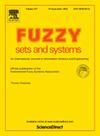多通道DoS攻击下模糊奇摄动系统的双速率安全控制
IF 2.7
1区 数学
Q2 COMPUTER SCIENCE, THEORY & METHODS
引用次数: 0
摘要
研究了存在拒绝服务攻击的模糊奇摄动系统的双速率安全控制问题。与众所周知的单速率事件触发机制不同,双速率事件触发机制分离了快、慢状态组件的触发条件,优化了数据传输,显著降低了通信开销。与马尔可夫链不同,采用非齐次逗留概率信息准确表征多通道DoS攻击的随机发生。提出了一种新的双速率控制策略,在保证控制效果的同时,将网络负荷降至最低。利用李雅普诺夫理论,给出了系统的随机稳定性分析和控制器综合的条件。最后,通过两个仿真实例验证了所提方法的有效性和优越性。本文章由计算机程序翻译,如有差异,请以英文原文为准。
Dual-rate security control for fuzzy singularly perturbed systems with multi-channel DoS attacks
This paper addresses the dual-rate security control for fuzzy singularly perturbed systems in the presence of denial of service (DoS) attacks. Unlike the well-known single-rate event-triggered mechanism, the dual-rate event-triggered mechanism separates the triggering conditions for fast and slow state components, optimizing data transmission and significantly reducing communication overhead. Differentiating from the Markov chain, the nonhomogeneous sojourn probability information is adopted to accurate characterize the stochastic occurrence of multi-channel DoS attacks. A novel dual-rate control strategy is also proposed, utilizing different sampling rates for fast and slow states, ensuring control effectiveness while minimizing network burden. In virtue of Lyapunov theory, the analysis for stochastic stability and conditions for controller synthesis are derived. Eventually, the effectiveness and superiority of the proposed methodology is verified through two simulation examples.
求助全文
通过发布文献求助,成功后即可免费获取论文全文。
去求助
来源期刊

Fuzzy Sets and Systems
数学-计算机:理论方法
CiteScore
6.50
自引率
17.90%
发文量
321
审稿时长
6.1 months
期刊介绍:
Since its launching in 1978, the journal Fuzzy Sets and Systems has been devoted to the international advancement of the theory and application of fuzzy sets and systems. The theory of fuzzy sets now encompasses a well organized corpus of basic notions including (and not restricted to) aggregation operations, a generalized theory of relations, specific measures of information content, a calculus of fuzzy numbers. Fuzzy sets are also the cornerstone of a non-additive uncertainty theory, namely possibility theory, and of a versatile tool for both linguistic and numerical modeling: fuzzy rule-based systems. Numerous works now combine fuzzy concepts with other scientific disciplines as well as modern technologies.
In mathematics fuzzy sets have triggered new research topics in connection with category theory, topology, algebra, analysis. Fuzzy sets are also part of a recent trend in the study of generalized measures and integrals, and are combined with statistical methods. Furthermore, fuzzy sets have strong logical underpinnings in the tradition of many-valued logics.
 求助内容:
求助内容: 应助结果提醒方式:
应助结果提醒方式:


